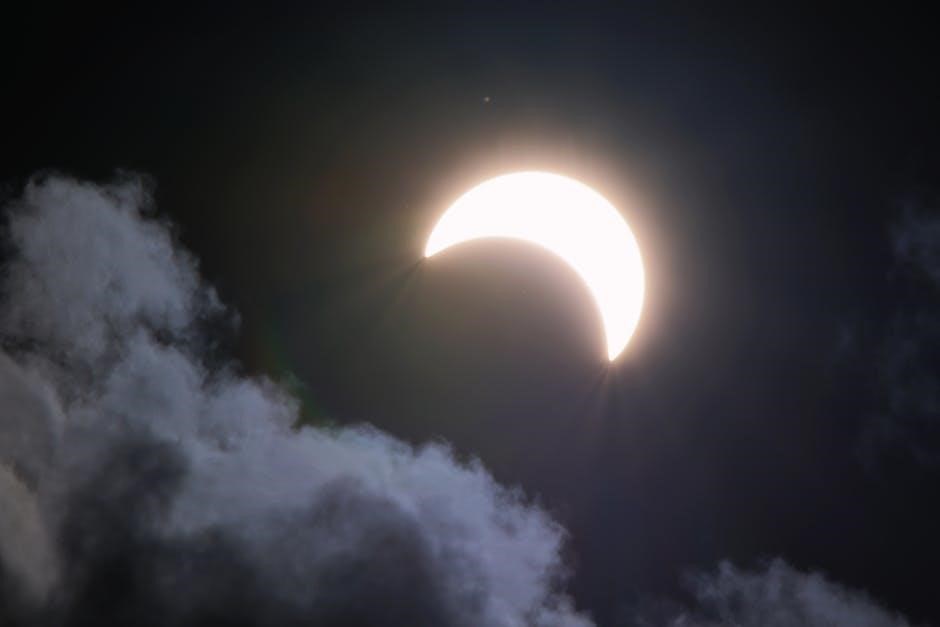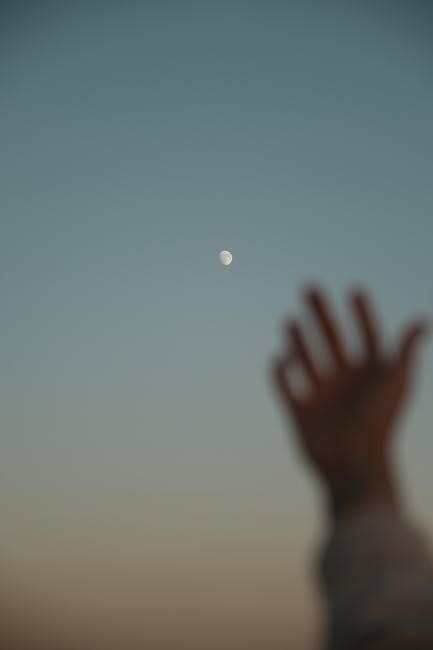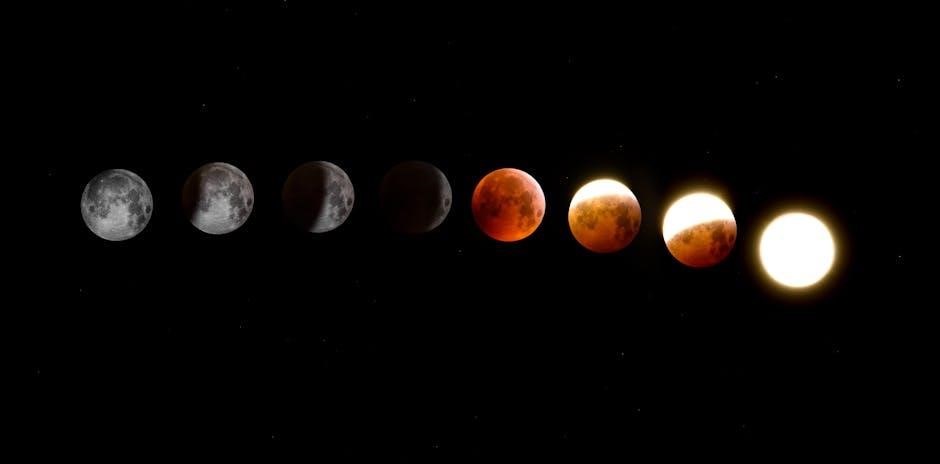Eclipses are fascinating celestial events with specific conditions and types. Solar eclipses occur when the Moon blocks sunlight, while lunar eclipses happen when Earth blocks moonlight. Understanding their mechanics, safety, and educational resources enhances appreciation for these phenomena, making eclipse questions and answers PDF guides invaluable for learners.
1.1 What is an Eclipse?
An eclipse occurs when one celestial body moves into the shadow of another, blocking light. A solar eclipse happens when the Moon passes between the Sun and Earth, partially or totally obscuring sunlight. A lunar eclipse occurs when Earth positions itself between the Sun and Moon, casting a shadow on the Moon. Eclipses are rare due to the specific alignment required, involving the Sun, Moon, and Earth, and can be total, partial, or penumbral, depending on the extent of the shadow’s coverage.
1.2 Types of Eclipses: Solar and Lunar
Eclipses are categorized into solar and lunar based on the celestial bodies involved. A solar eclipse occurs during a new moon when the Moon passes between the Sun and Earth, partially or totally blocking sunlight. A lunar eclipse happens during a full moon when Earth positions itself between the Sun and Moon, casting a shadow on the lunar surface. Solar eclipses can be total, annular, or partial, while lunar eclipses can be total, partial, or penumbral, depending on the alignment and shadow coverage.

Solar Eclipses
A solar eclipse occurs when the Moon passes between the Sun and Earth, temporarily blocking sunlight. It can be total, annular, or partial, depending on alignment.
2.1 What is a Solar Eclipse?
A solar eclipse is a rare celestial event where the Moon passes directly between the Sun and Earth, blocking the Sun’s light. This alignment can result in three types of eclipses: total, annular, or partial. During a total solar eclipse, the Moon completely covers the Sun, revealing the solar corona. Annular eclipses occur when the Moon appears smaller, creating a ring of light, while partial eclipses only partially obscure the Sun. Solar eclipses are awe-inspiring phenomena that captivate observers worldwide, offering unique opportunities to study the Sun’s structure and behavior.
2.2 Types of Solar Eclipses: Total, Annular, and Partial
Solar eclipses are categorized into three types: total, annular, and partial. A total solar eclipse occurs when the Moon entirely covers the Sun, revealing the solar corona. An annular eclipse happens when the Moon appears smaller, creating a ring of light around it. A partial eclipse occurs when only part of the Sun is obscured. Each type depends on the Moon’s distance from Earth, with total eclipses being the rarest and most awe-inspiring. Understanding these types enhances appreciation for these celestial events.
2.3 Safety Tips for Viewing Solar Eclipses
Viewing solar eclipses requires caution to protect eye health. Directly observing the Sun, even during an eclipse, can cause solar retinopathy. Use certified solar viewing glasses or handheld solar viewers with ISO 12312-2 certification. Never look through unfiltered binoculars or telescopes. Ensure children are supervised. Avoid homemade filters, as they may not provide adequate protection. Safe viewing ensures an enjoyable and risk-free experience during this rare phenomenon.

Lunar Eclipses
Lunar eclipses occur when Earth blocks sunlight from reaching the Moon during a full moon. They can be total, partial, or penumbral, offering unique celestial observation opportunities.
3.1 What is a Lunar Eclipse?
A lunar eclipse occurs during a full moon when Earth is positioned between the Sun and the Moon, blocking sunlight from reaching the lunar surface. There are three types: total, partial, and penumbral. In a total lunar eclipse, the Moon enters Earth’s umbra, often turning reddish due to scattered sunlight. Partial eclipses involve only part of the Moon in the umbra, while penumbral eclipses result from the Moon passing through Earth’s penumbra, causing a subtle darkening. Lunar eclipses are safe to observe with the naked eye and offer striking celestial displays.
3.2 Types of Lunar Eclipses: Total, Partial, and Penumbral
Lunar eclipses are categorized into three types based on the Moon’s position relative to Earth’s shadow. A total lunar eclipse occurs when the Moon is entirely within Earth’s umbra, often appearing reddish. A partial lunar eclipse happens when only a portion of the Moon enters the umbra, creating a visible “bite.” Penumbral eclipses are subtler, as the Moon passes through Earth’s penumbra, causing a slight darkening. Each type offers unique visual effects, making lunar eclipses captivating astronomical events.
3.3 Why Lunar Eclipses are More Frequent than Solar Eclipses
Lunar eclipses occur more frequently than solar eclipses because they can be observed from anywhere on Earth during a full moon. Earth’s shadow is larger relative to the Moon, making it easier for the Moon to pass through it entirely or partially. Additionally, lunar eclipses require less precise alignment of celestial bodies, as they can occur whenever the Moon is full and properly aligned with the Sun and Earth. This alignment happens more often, unlike solar eclipses, which depend on specific conditions.

Conditions for Eclipses
Eclipses occur when the Sun, Moon, and Earth align precisely, with the Moon passing through Earth’s shadow during a lunar eclipse and vice versa for solar eclipses. Specific celestial alignments and the presence of lunar nodes are critical for these events to happen, ensuring the necessary conditions for shadows to form and obstruct light effectively.
4.1 Alignment of the Sun, Moon, and Earth
Eclipses occur when the Sun, Moon, and Earth align in a straight line, a rare celestial event. During a solar eclipse, the Moon is positioned between the Sun and Earth, casting its shadow on our planet. Conversely, a lunar eclipse happens when Earth is between the Sun and Moon, casting its shadow on the Moon. This precise alignment is essential for eclipses to occur, as it allows the necessary shadowing effect to take place, making these events both rare and astronomically significant.
4.2 The Role of Lunar Nodes
Lunar nodes are critical for eclipses, as they are the points where the Moon’s orbit intersects Earth’s orbital plane around the Sun. Eclipses only occur when the Moon is near these nodes during a new or full moon. The nodes’ positions determine the type and frequency of eclipses. Solar eclipses happen when the Moon is at the ascending node, while lunar eclipses occur at the descending node. The nodes’ alignment with the Sun and Moon dictates the timing and visibility of these celestial events, making them essential for eclipse occurrence.

Eclipse Frequency and Timing
Eclipses occur periodically due to the alignment of the Sun, Moon, and Earth. The Moon’s orbit inclination affects their frequency. About two to five eclipses happen annually, with solar eclipses being less frequent than lunar ones. The timing varies, but eclipses don’t occur every month because the Moon’s orbit isn’t perfectly aligned with Earth’s orbital plane around the Sun. This alignment is necessary for an eclipse to occur, making them rare and predictable events.
5.1 How Often Do Eclipses Occur?
Eclipses occur relatively frequently, with about two to five eclipses happening each year. This includes both solar and lunar eclipses. Solar eclipses are less common than lunar eclipses because the Moon’s shadow has a smaller area on Earth. The frequency of eclipses is determined by the alignment of the Sun, Moon, and Earth, which must be precise for an eclipse to occur. Additionally, the Moon’s orbital nodes play a crucial role in the timing and frequency of these events, ensuring they don’t happen every month.
5.2 Why Solar Eclipses Don’t Happen Every Month
Solar eclipses don’t occur every month due to the Moon’s elliptical orbit and the tilt of its orbital plane relative to Earth. This misalignment means the Moon’s shadow rarely intersects Earth’s surface. Additionally, the timing of the new moon phase, necessary for solar eclipses, doesn’t always align with the lunar nodes, which are essential for an eclipse. These factors combined ensure solar eclipses are infrequent and don’t happen monthly, making them rare and special events for observers.

Viewing and Observing Eclipses
Understanding how to safely view eclipses is essential. Use ISO-certified solar viewers for solar eclipses, while lunar eclipses can be observed with the naked eye or optics for better clarity.
6.1 Best Practices for Observing Eclipses
Observing eclipses requires preparation and safety. For solar eclipses, always use ISO-certified solar glasses or hand-held viewers to protect eyes. During lunar eclipses, no eye protection is needed, but binoculars can enhance the experience. Ensure a clear horizon view, dress appropriately for weather, and minimize distractions. Properly align telescopes if used, and follow all safety guidelines to fully enjoy these celestial events without risks.
6.2 Tools and Equipment for Safe Viewing
Essential tools for safe eclipse viewing include ISO-certified solar glasses or handheld solar viewers with a solar filter. Telescopes and binoculars require proper solar filters to prevent eye damage. For lunar eclipses, no special eye protection is needed, but binoculars can enhance viewing. Always ensure equipment is designed for solar observation to avoid harm. Properly fitted solar glasses with unscratched lenses are crucial for direct sun viewing during solar eclipses, ensuring a safe and enjoyable experience.

Eclipse Questions and Answers
Key questions include: What causes eclipses? How often do they occur? What safety precautions are necessary? Understanding these basics enhances appreciation of solar and lunar events.
7.1 Common Questions About Solar Eclipses
Common questions about solar eclipses include understanding their occurrence, types, and safety. A solar eclipse happens when the Moon blocks sunlight, casting shadows on Earth. It occurs during a new moon when the Moon, Sun, and Earth align. Types include total, annular, and partial eclipses. Viewing requires special eyewear to prevent eye damage. Solar eclipses are rare due to the Moon’s shadow being narrow. They inspire curiosity and scientific inquiry, making them a popular topic for educational resources and discussions.
7.2 Common Questions About Lunar Eclipses
Common questions about lunar eclipses focus on their visibility, types, and frequency. Lunar eclipses occur during a full moon when Earth blocks sunlight from reaching the Moon. They are more frequent than solar eclipses due to the larger size of Earth’s shadow. Types include total, partial, and penumbral eclipses; Unlike solar eclipses, lunar eclipses are safe to view with the naked eye. They often turn the Moon red, creating a “Blood Moon.” Lunar eclipses are observable from anywhere on Earth’s night side, making them accessible to a wider audience.

Educational Resources
Eclipse questions and answers PDF guides provide comprehensive learning tools. Worksheets and activity guides help students engage with eclipse concepts, while PDF resources offer detailed explanations for educators and learners alike.
8.1 Eclipse Worksheets and Activity Guides
Eclipse worksheets and activity guides are essential tools for engaging students in astronomy. These resources include quizzes, diagrams, and exercises that explore solar and lunar eclipses. Interactive activities help students understand the alignment of celestial bodies and the science behind eclipses. Worksheets often cover types of eclipses, safety tips, and frequency. They cater to different learning levels, making complex concepts accessible. Many guides align with curriculum standards, providing educators with structured lesson plans. Printable PDF formats ensure easy distribution and use in classrooms or at home.
8.2 PDF Guides for Students and Educators
PDF guides for students and educators offer comprehensive resources to explore eclipses. These guides include detailed explanations, diagrams, and quizzes to enhance learning. They cover topics like solar and lunar eclipse mechanics, safety tips, and historical data. Designed for various educational levels, these guides align with curriculum standards, providing structured lesson plans. Educators can use them to create engaging classroom activities, while students benefit from interactive exercises. Printable formats make them accessible for both teachers and learners, fostering a deeper understanding of celestial events.
Eclipses are awe-inspiring events that captivate humanity, blending astronomy and education. Understanding their science and safety fosters curiosity and appreciation for celestial wonders, inspiring further exploration and learning.
9.1 Summary of Key Points
Eclipses occur due to precise alignments of the Sun, Moon, and Earth. Solar eclipses happen during a new moon, while lunar eclipses occur at full moon. There are three types of solar eclipses: total, annular, and partial. Lunar eclipses can be total, partial, or penumbral. Viewing solar eclipses requires safety measures like special glasses. Lunar eclipses are more frequent and safer to observe. Understanding the science and frequency of eclipses enhances appreciation for these celestial events, encouraging further exploration and learning about astronomy.
9.2 Encouragement to Explore More About Eclipses
Eclipses are awe-inspiring events that spark curiosity and wonder. Exploring these phenomena can deepen your understanding of astronomy and our universe. Utilize resources like eclipse questions and answers PDF guides to learn more about their science, safety, and significance. Observing eclipses can be a lifelong passion, fostering a deeper connection to celestial mechanics. Embrace the opportunity to explore further and uncover the fascinating details behind these extraordinary occurrences, enhancing your appreciation for the cosmos.
